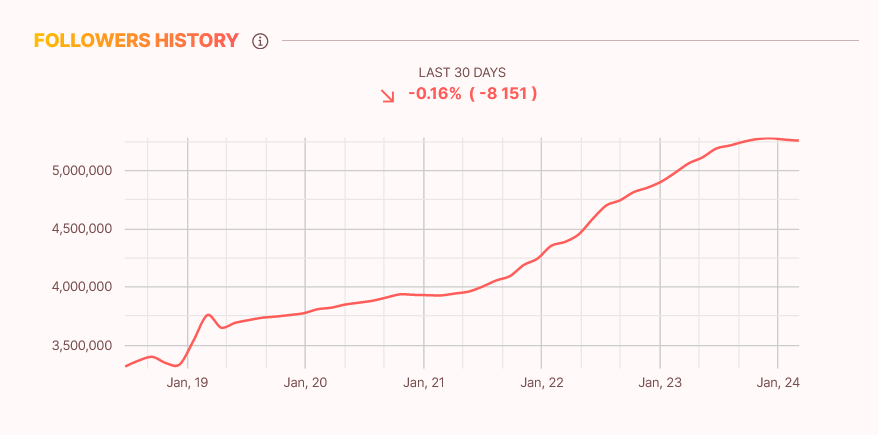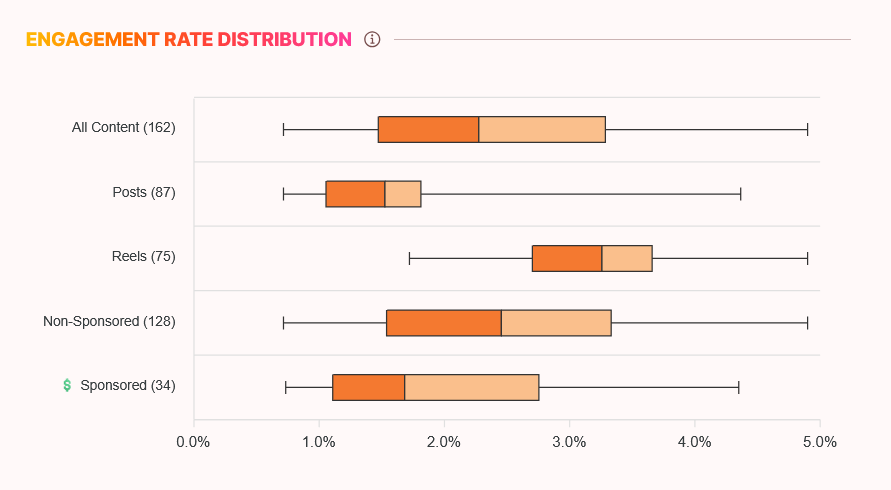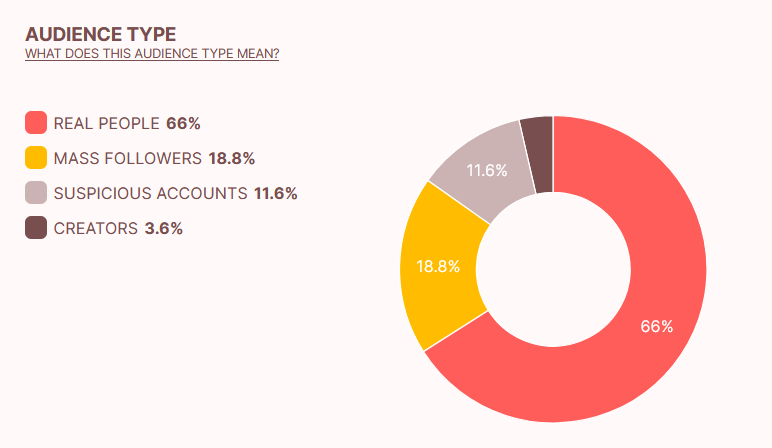
In influencer marketing, choosing the right influencers for your campaign is crucial. But how can you ensure that you choose those who perform well on social media platforms while also aligning with your target audience? The answer lies in using key performance indicators (KPIs) as a reference to help you identify the right content creators based on data. Whether you use an influencer search platform such as influData or gather data manually, choosing the right influencer KPIs is crucial for identifying the best influencers for your campaign. Here are the most important influencer KPIs you should consider when conducting a search and to determine the most suitable creators for your campaign:
Start your influencer search with the creator’s follower numbers. It is important to note that a large number of followers does not always equate to high quality or relevance for your campaign. Influencers can be classified based on community size: Nano-influencers have between 1,000 and 10,000 followers, whereas micro-influencers have 10,000 to 50,000 followers. There are also mid-tier influencers (50,000 to 500,000 followers), macro-influencers (500,000 to 1 million followers) and mega-influencers (1 million to 5 million followers). However, a smaller community is not necessarily a disadvantage, as the followers of these influencers generally have more engagement within the community. Not only does a higher engagement rate favor micro or nano creators, but their increased credibility also plays a role – since they are more likely to be perceived as friends – and their focus on specific topics where they possess particular expertise. Micro- and nano-influencers are often experts in specific fields and have a loyal fan base that is interested in their dedicated content.
When selecting the right number of followers, it is therefore important to consider the marketing objective of the campaign. For brand awareness and reach, macro and mega influencers with their large follower numbers can be advantageous. For engagement with the community, micro and nano influencers with their smaller but more interactive community are often more effective. For a balanced mix of reach and engagement, combining micro/nano creators with influencers who have a high reach could be fruitful, or opting for mid-tier influencers might be a wise choice. These influencers boast a substantial follower count and often have an engaged community, allowing them to generate both wide reach and meaningful interaction.
Follower growth rate is an important indicator of an account’s future value and a particularly critical metric for marketers who focus more on relationships with content creators than on short-term promotions. For example, an influencer with 300,000 followers and a 10% growth rate will eventually outperform a channel with a 1% growth rate and 750,000 followers. Growth is crucial for identifying up-and-coming and trending influencers and can be particularly valuable when looking for testimonials and brand ambassadors.
If you use the influencer search platform influData, a graph will give you an insight into the development of follower numbers over the last few years. A percentage value for the change in follower numbers over the last 30 days is also provided. The long-term trend provides information about the continuity and growth potential of the influencer, while the short-term change within the last 30 days provides insights into current trends or events. If you recognise a long-term positive development – as in this example – but a current negative trend, you should take another close look at how active the influencer is at the moment and whether there are any shitstorms or negative headlines about them. Short-term upward spikes, on the other hand, may indicate a follower purchase. A negative follower trend or fluctuating ups and downs in growth are unfavorable indicators.

If you gather the data manually instead, it takes significantly more time and effort, but the analysis can still be extremely valuable. By tracking an influencer’s follower numbers across different platforms and updating them at regular intervals, you can get a comprehensive picture of their development over time.
Even though other criteria, such as engagement rate or the quality and authenticity of an influencer’s audience, play a more significant role in influencer selection than reach, you still likely want to know how many people will see your creators’ posts. This is important, if only to calculate comparable CPMs (cost per thousand impressions) with other advertising channels. Not every follower automatically sees all of an influencer’s posts. Reach – the number of views per post, story, or reel – indicates how many people are actually reached, regardless of the total number of followers. In particular, Instagram Stories’ actual reach is not publicly visible, meaning this value must be estimated using algorithms. An influencer marketing tool like influData provides you with these metrics for each creator, eliminating the need for manual calculations or estimations.
The key takeaway is: An influencer with many followers does not necessarily have a high reach or high view counts. To better assess an influencer’s actual reach, you should not focus on a single post but rather track the development of views over a longer period.
The engagement rate provides information on how actively and enthusiastically an influencer’s followers interact with their content. Influencer search platforms provide you with this information without much effort. Alternatively, you can also calculate the engagement rate yourself by dividing the number of interactions (likes, comments, and – depending on the platform – also shares) by the total number of followers. The average engagement rate on Instagram, for example, is usually between 2% and 6%. So if an influencer has an engagement rate of 10% on Instagram, for example, this is considered above average. However, it is important to note that a high engagement rate alone is not necessarily meaningful. The quality of engagement also plays an important role in the evaluation of an influencer.
In addition to engagement rate itself, you should also consider the range or fluctuation of engagement across an influencer’s content. Look at individual posts to determine where engagement rates fall. This will help you assess whether an influencer’s overall engagement rate is affected by outliers, if engagement fluctuates significantly, or if it remains stable within a specific range. For planning with a creator, this is of great importance, as it allows you to better estimate the engagement rate you can expect. A narrow range of engagement indicates stable performance and enables precise planning, whereas a broad range suggests fluctuations, which may offer potential for high reach but also pose the risk of underperformance. In short, you are on safer ground when an influencer’s engagement remains within a consistent range. A tool like influData can handle this work for you and provide such ranges without requiring you to manually check all of an influencer’s individual content pieces.

Influencer marketing platforms such as influData give you a well-founded assessment of how authentic influencers are. The tools make it possible to recognise suspicious activities such as fake followers or manipulated engagement at an early stage and evaluate the profiles with an authenticity score. In this way, you can minimise the risk of fraud and ensure that your campaign is built on a sincere foundation. Influencers with a higher score tend to be more trustworthy and can demonstrate a genuine connection to their target audience, leading to more effective collaboration.

You can also use a tool like infludata to analyze the authenticity and, therefore, the quality of an influencer’s followers. It’s not only the authenticity of the influencer themselves that matters, but also the quality of their audience, as this is the group you aim to reach through the creator. Analyzing the composition of followers provides you with critical insights that go far beyond simple follower numbers. An influencer’s audience determines how effectively your marketing message reaches the target group. Only genuine followers guarantee active users as well as reactions and interactions. On the other hand, suspicious or inactive accounts, mass followers, or creator followers are lower-quality audience members and should be avoided in large numbers.

It is more difficult to check authenticity manually, but it is not impossible. For example, you can go through an influencer’s follower lists and look out for suspicious profiles. A large number of inactive follower profiles, followers without a profile picture or with cryptic names such as User10872 or Hannah6789 can be an indication of suspicious irregularities. You can also analyse the interaction patterns in the influencer’s content and check whether the comments appear authentic or may have been manipulated. For example, recurring one-word comments such as “super”, “awesome” or “wow” or simply commenting with one or more emojis could be indications of unnatural comments. It takes more time and effort, but a thorough, manual review can still provide valuable insights to assess the credibility of an influencer.
Another relevant aspect of checking an influencer profile is the audience report provided by some influencer search platforms. This report provides detailed insights into the demographic characteristics of a content creator’s followers, including age, gender, language, and origin. By analysing this data, you can determine whether the composition of the influencer’s community matches your own target group. For example, if your products and services are aimed exclusively at the DACH region, but the creator’s followers are predominantly from the USA, there is no brand fit.

This point is much more difficult to analyse manually, as it requires extensive data that is often not publicly available. To get a rough idea of the influencer’s community, you could look at the comments under their posts or take a look at individual profiles as examples to gain insights into the demographic characteristics and interests of their followers.
Although it can be tempting to simply trust your gut feeling and hope that the creators you choose will perform well during your campaign, it is advisable to take a data-driven approach. Whether you use creator platforms such as influData or do it manually, choosing the right influencer KPIs is essential if you want to ensure that your campaign achieves the desired results. In addition to the KPIs listed here, there are many others that may be relevant to your brand. Which influencer KPIs make the most sense depends on the specific goals and requirements of your campaign. It’s important to choose the metrics that best align with your marketing goals and provide you with the most relevant insights. However, also consider the qualitative aspects of an influencer, such as visual presentation and writing style, which can provide further insight into whether a creator is a suitable match for you and your brand. Ultimately, it is the overall package of quantitative KPI data on the one hand and high-quality standards on the other that will influence the success of your influencer campaign.
Non-binding and no payment details needed
Start Now